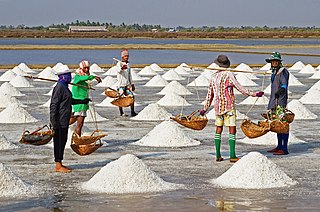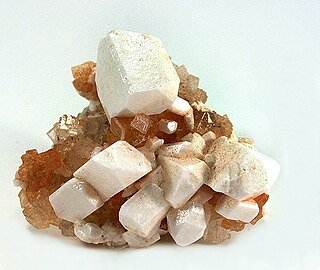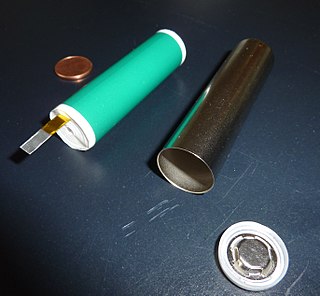Related Research Articles

Lithium carbonate is an inorganic compound, the lithium salt of carbonic acid with the formula Li
2CO
3. This white salt is widely used in processing metal oxides. It is on the World Health Organization's List of Essential Medicines for its efficacy in the treatment of mood disorders such as bipolar disorder.

Brine is water with a high-concentration solution of salt. In diverse contexts, brine may refer to the salt solutions ranging from about 3.5% up to about 26%. Brine forms naturally due to evaporation of ground saline water but it is also generated in the mining of sodium chloride. Brine is used for food processing and cooking, for de-icing of roads and other structures, and in a number of technological processes. It is also a by-product of many industrial processes, such as desalination, so it requires wastewater treatment for proper disposal or further utilization.

Sea salt is salt that is produced by the evaporation of seawater. It is used as a seasoning in foods, cooking, cosmetics and for preserving food. It is also called bay salt, solar salt, or simply salt. Like mined rock salt, production of sea salt has been dated to prehistoric times.

Seawater, or sea water, is water from a sea or ocean. On average, seawater in the world's oceans has a salinity of about 3.5%. This means that every kilogram of seawater has approximately 35 grams (1.2 oz) of dissolved salts. The average density at the surface is 1.025 kg/L. Seawater is denser than both fresh water and pure water because the dissolved salts increase the mass by a larger proportion than the volume. The freezing point of seawater decreases as salt concentration increases. At typical salinity, it freezes at about −2 °C (28 °F). The coldest seawater still in the liquid state ever recorded was found in 2010, in a stream under an Antarctic glacier: the measured temperature was −2.6 °C (27.3 °F).
The Solvay process or ammonia–soda process is the major industrial process for the production of sodium carbonate (soda ash, Na2CO3). The ammonia–soda process was developed into its modern form by the Belgian chemist Ernest Solvay during the 1860s. The ingredients for this are readily available and inexpensive: salt brine (from inland sources or from the sea) and limestone (from quarries). The worldwide production of soda ash in 2005 was estimated at 42 million tonnes, which is more than six kilograms (13 lb) per year for each person on Earth. Solvay-based chemical plants now produce roughly three-quarters of this supply, with the remaining being mined from natural deposits. This method superseded the Leblanc process.

In common usage, salt is a mineral composed primarily of sodium chloride (NaCl). When used in food, especially in granulated form, it is more formally called table salt. In the form of a natural crystalline mineral, salt is also known as rock salt or halite. Salt is essential for life in general, and saltiness is one of the basic human tastes. Salt is one of the oldest and most ubiquitous food seasonings, and is known to uniformly improve the taste perception of food, including otherwise unpalatable food. Salting, brining, and pickling are also ancient and important methods of food preservation.
A bromide ion is the negatively charged form (Br−) of the element bromine, a member of the halogens group on the periodic table. Most bromides are colorless. Bromides have many practical roles, being found in anticonvulsants, flame-retardant materials, and cell stains. Although uncommon, chronic toxicity from bromide can result in bromism, a syndrome with multiple neurological symptoms. Bromide toxicity can also cause a type of skin eruption, see potassium bromide. The bromide ion has an ionic radius of 196 pm.

Searles Lake is an endorheic dry lake in the Searles Valley of the Mojave Desert, in northwestern San Bernardino County, California. The lake in the past was also called Slate Range Lake and Borax Lake.

Lake Assal is a crater lake in central-western Djibouti. It is located at the western end of Gulf of Tadjoura between Arta Region, and Tadjoura Region, touching Dikhil Region, at the top of the Great Rift Valley, some 120 km (75 mi) west of Djibouti city. Lake Assal is a saline lake that lies 155 m (509 ft) below sea level in the Afar Triangle, making it the lowest point on land in Africa and the third-lowest point on Earth after the Sea of Galilee and the Dead Sea. No outflow occurs from the lake, and due to high evaporation, the salinity level of its waters is 10 times that of the sea, making it the fourth most saline body of water in the world, behind Garabogazköl, Lake Retba, and Gaet'ale Pond. The salt in the lake is exploited under four concessions awarded in 2002 at the southeast end of the lake; the major share of production is held by Société d’Exploitation du Lac and Société d’Exploitation du Salt Investment S.A de Djibouti.

Compass Minerals International, Inc is an American public company that, through its subsidiaries, is a leading producer of minerals, including salt, magnesium chloride and sulfate of potash. Based in Overland Park, Kansas; the company provides bulk treated and untreated highway deicing salt to customers in North America and the United Kingdom and plant nutrition products to growers worldwide. Compass Minerals also produces consumer deicing and water conditioning products, consumer and commercial culinary salt, and other mineral-based products for consumer, agricultural and industrial applications. In addition, Compass Minerals provides records management services to businesses throughout the United Kingdom.

Sociedad Química y Minera de Chile (SQM) is a Chilean chemical company and a supplier of plant nutrients, iodine, lithium and industrial chemicals. It is the world's biggest lithium producer.

Evaporation ponds are artificial ponds with very large surface areas that are designed to efficiently evaporate water by sunlight and expose water to the ambient temperatures. Evaporation ponds are inexpensive to design making it ideal for multiple purposes such as wastewater treatment processes, storage, and extraction of minerals. Evaporation ponds differ in usage and result in a wide range of environmental and health effects.

Searles Valley Minerals Inc. is a raw materials mining and production company with corporate offices in Overland Park, Kansas. It is owned by the Indian company Nirma. It has major operations in the Searles Valley centered in Trona, California where it is the town's largest employer. The company produces borax, boric acid, soda ash, salt cake, and salt. It also owns the Trona Railway.
Coloured Ties Capital Inc., formerly known as GrowMax Resources, is a Canadian mining and speciality chemicals and minerals company.
Bromine production in the United States of 225,000 tonnes in 2013 made that country the second-largest producer of bromine, after Israel. The US supplied 29 percent of world production. Since 2007, all US bromine has been produced by two companies in southern Arkansas, which extract bromine from brine pumped from the Smackover Formation. At an advertised price of US$3.50 to US$3.90 per kg, the US 2013 US production would have a value of roughly US$800 million.

Leonite is a hydrated double sulfate of magnesium and potassium. It has the formula K2SO4·MgSO4·4H2O. The mineral was named after Leo Strippelmann, who was director of the salt works at Westeregeln in Germany. The mineral is part of the blodite group of hydrated double sulfate minerals.
Petrolithium is lithium derived from petroleum brine, the mineral-rich salt solution that is brought to the surface during oil and gas production and exploration.

Lithium batteries are primary batteries that use lithium as an anode. This type of battery is also referred to as a lithium-ion battery and is most commonly used for electric vehicles and electronics. The first type of lithium battery was created by the British chemist M. Stanley Whittingham in the early 1970s and used titanium and lithium as the electrodes. Applications for this battery were limited by the high prices of titanium and the unpleasant scent that the reaction produced. Today's lithium-ion battery, modeled after the Whittingham attempt by Akira Yoshino, was first developed in 1985.

Cornish Lithium is a mineral exploration and development company based in Cornwall, United Kingdom. The company was founded by Jeremy Wrathall in 2016.
Lithium Valley is an area adjacent to the Salton Sea in Southern California, United States, with enormous deposits of lithium. Due to increased demand for lithium, which is crucial component for batteries used for electric cars and energy storage, the area is attracting attention, and the extraction of lithium is expected to boost the economy of Imperial County. The area is exceptionally well-suited due to the ability to mine the lithium while generating geothermal power. There are already 11 geothermal power plants utilizing the Salton Sea Geothermal Field.
References
- ↑ Panagopoulos, Argyris; Haralambous, Katherine-Joanne (2020-12-01). "Environmental impacts of desalination and brine treatment - Challenges and mitigation measures". Marine Pollution Bulletin. 161 (Pt B): 111773. Bibcode:2020MarPB.16111773P. doi:10.1016/j.marpolbul.2020.111773. ISSN 0025-326X. PMID 33128985. S2CID 226224643.
- 1 2 Panagopoulos, Argyris; Haralambous, Katherine-Joanne (2020-10-01). "Minimal Liquid Discharge (MLD) and Zero Liquid Discharge (ZLD) strategies for wastewater management and resource recovery – Analysis, challenges and prospects". Journal of Environmental Chemical Engineering. 8 (5): 104418. doi:10.1016/j.jece.2020.104418. ISSN 2213-3437. S2CID 225309628.
- ↑ Tom (1989), 103.
- 1 2 Krebs, Robert E.; Krebs, Carolyn A. (2003). Groundbreaking Scientific Experiments, Inventions, and Discoveries of the Ancient World . Greenwood (published December 30, 2003). pp. 255–256. ISBN 978-0313313424.
- 1 2 Warren, John K. (2016). Evaporites: A Geological Compendium. Springer (published May 18, 2016). p. 1034.
- 1 2 3 W. L. Bourcier, M. Lin, and G. Nix, Recovery of Minerals and Metals from Geothermal Fluids, Lawrence Livermore National Laboratory, 8 September 2005
- 1 2 R. Gordon Bloomquist, "Economic benefits of mineral extraction from geothermal brines," 2006, Washington State University Extension Energy Program.
- ↑ Roth, Sammy (2019-10-14). "Lithium will fuel the clean energy boom. This company may have a breakthrough". Los Angeles Times . Retrieved 2019-10-17.
- 1 2 Donald E. White, "Saline waters in sedimentary rocks", in Addison Young and John E. Galley (eds.), Fluids in Subsurface Environments, American Association of Petroleum Geologists, Memoir 4, 1965.
- 1 2 F. F. Wright, "Minerals of the ocean," in Frank E. Firth (ed.), The Encyclopedia of Marine Resources (New York: Van Nostrand, 1969) 406–407.
- 1 2 3 P. Evan Dresel and Athur W. Rose, Chemistry and Origin of Oil and Gas Well Brines in Western Pennsylvania, Pennsylvania Geological Survey, Open-File Report OFOG 10=01.0, 2010.
- 1 2 3 Projects Olaroz, Orocobre website, accessed 17 March 2016.
- 1 2 3 Greta J. Orris, Deposit model for closed-basin potash-bearing brines, US Geological Survey, Open-File Report 2011-1283, 2011.
- ↑ Stephen M. Jasinski, "Potash," US Geological Survey, 2013 Minerals Yearbook, August 2015.
- ↑ J. R. Davis and J. D. Vine, "Stratigraphic and tectonic setting of the lithium brine field, Clayton Valley, Nevada," in Basin and Range Symposium, Rocky Mountain Association of Geologists, Utah Geological Association, 1979.
- 1 2 "Cornish Lithium Releases Globally Significant Lithium Grades". Cornish Lithium . 17 September 2020. Retrieved 17 July 2021.
- ↑ "Anson Resources experiences improved exploration success close to Long Canyon area". 7 May 2018. Retrieved 7 June 2019.
- 1 2 3 4 5 "142 ppm Li Assay Result from Artesian Flow Horizon". 19 April 2018. Retrieved 7 June 2019.
- 1 2 Schultze, L. E.; Bauer, D. J. (1982). Operation of a mineral recovery unit on brine from the Salton Sea known geothermal resource area (Report). Bureau of Mines Report of Investigations. US Bureau of Mines. p. 3. Retrieved March 9, 2022.
- ↑ US Geological Survey, Lithium, Mineral Commodity Summary, 2016.
- ↑ Dwight Bradley and others, "A preliminary deposit model for lithium brines," US Geological Survey, Open-File Report 2013–1006, 2013.
- ↑ Kaneya, Rui (April 13, 2015). "Could Hawaii Geothermal Plant Become a Windfall for Public?". Civil Beat. Retrieved March 13, 2016.
- ↑ Rockstone Research (https://www.rockstone-research.com/images/PDF/MGX20en.pdf
- ↑ "Lithium de France: geothermal brines for lithium extraction". Innovation News Network. 2022-02-22. Retrieved 2022-07-11.
- ↑ GeoEnergy, Think (2022-07-08). "Vulcan and Enel to jointly develop Cesano geothermal lithium project in Italy" . Retrieved 2022-07-11.
- ↑ Boschetti, Tiziano (2022-01-01). "A revision of lithium minerals thermodynamics: Possible implications for fluids geochemistry and geothermometry". Geothermics. 98: 102286. Bibcode:2022Geoth..9802286B. doi:10.1016/j.geothermics.2021.102286. ISSN 0375-6505. S2CID 244036105.
- ↑ Sanjuan, Bernard; Gourcerol, Blandine; Millot, Romain; Rettenmaier, Detlev; Jeandel, Elodie; Rombaut, Aurélien (2022-05-01). "Lithium-rich geothermal brines in Europe: An up-date about geochemical characteristics and implications for potential Li resources". Geothermics. 101: 102385. Bibcode:2022Geoth.10102385S. doi: 10.1016/j.geothermics.2022.102385 . ISSN 0375-6505. S2CID 247240697.
- ↑ Boschetti, Tiziano (2022-11-01). "Comments on "Lithium-rich geothermal brines in Europe: An up-date about geochemical characteristics and implications for potential Li resources" by Sanjuan etal. (2022)". Geothermics. 105: 102518. Bibcode:2022Geoth.10502518B. doi:10.1016/j.geothermics.2022.102518. ISSN 0375-6505. S2CID 250395603.
- ↑ Jean E. Moran, "Origin of iodine in the Anadarko Basin, Oklahoma: an 129I study" AAPG Bulletin, May 1996, v.80 n.5 p.685–694.
- ↑ Iodine, US Geological Survey, Minerals Yearbook 2013
- ↑ Iodine [ permanent dead link ]
- ↑ S. T. Krukowski, "Iodine," Mining Engineering, June 2011, p.74.
- ↑ William H. Gross, "magnesium from the sea," in: Frank E. Firth (ed.) The Encyclopedia of Marine Resources (New York: Von Nostrand, 1969) 368-372.
- ↑ Marvin Lieberman, Magnesium, industry in transition Archived 2009-01-07 at the Wayback Machine , 2001.
- ↑ R. Gordon Bloomquist, ECONOMIC BENEFITS OF MINERAL EXTRACTION FROM GEOTHERMAL BRINES, Washington State University Extension Energy Program, 2006.
- ↑ S. Warren Hobbs and James E. Elliottt, "Tungsten," in Donald A. Brobst and Walden P. Pratt (eds.) United States Mineral Resources, US Geological Survey Professional Paper 820, 1973.
- ↑ P. B. Altringer and others, "Tungsten recovery from Searles Lake brines," US Bureau of Mines, Report of Investigation 8315, 1978.
- 1 2 F. F. Wright, "Minerals of the ocean," in Frank E. Firth (ed.), The Encyclopedia of Marine Resources (New York: Van Nostrand, 1969) 406-407.
- ↑ “Record haul of uranium harvested from seawater,” New Scientist, 22 Aug. 2012.
- ↑ “Breeder reactors: A renewable energy source,” Bernard L. Cohen, Department of Physics. University of Pittsburgh, January 1983
- ↑ Plazak, Dan A Hole in the Ground with a Liar at the Top (Salt Lake: Univ. of Utah Press, 2006) ISBN 0-87480-840-5 (contains a chapter on gold-from seawater swindles)
- ↑ Haber, F. (1927). "Das Gold im Meerwasser". Zeitschrift für Angewandte Chemie. 40 (11): 303–314. Bibcode:1927AngCh..40..303H. doi:10.1002/ange.19270401103.
- ↑ McHugh, J.B. (1988). "Concentration of gold in natural waters". Journal of Geochemical Exploration. 30 (1–3): 85–94. Bibcode:1988JCExp..30...85M. doi:10.1016/0375-6742(88)90051-9.